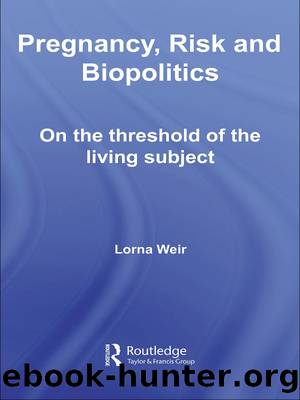Pregnancy, Risk and Biopolitics by Lorna Weir

Author:Lorna Weir [Weir, Lorna]
Language: eng
Format: epub
Tags: Law, Family Law, Children, Medical, Nursing, Maternity; Perinatal; Women's Health, Science, Philosophy & Social Aspects, Social Science, Feminism & Feminist Theory, Sociology, General, Women's Studies
ISBN: 9781134163564
Google: q8l8AgAAQBAJ
Publisher: Routledge
Published: 2006-09-27T04:40:13+00:00
The child en ventre sa mère as legal fiction
The legal fiction of the âchild en ventre sa mèreâ has existed for centuries in English common law and French civil law, the two legal systems that were received respectively into Anglo-Canadian and Quebec law. The fiction en ventre sa mère is currently entrenched in both Anglo-Canadian common law6 and the Quebec Civil Code7 with the effect of providing financial security for posthumously born children. In the event that the mother, or more typically the father, should die without a will or with a will containing no mention of future heirs from a pregnancy at the time of the testatorâs death, the posthumously born child will be read into the will as beneficiary. For this to occur, a number of conditions must obtain: (1) the child must be born alive; (2) the will must show no intent of exclusion; (3) the act of reading in must not be to the childâs detriment. Estate law principles exist to guard the property of the posthumous child while s/he has not yet been born. A guardian (called a curator in ventro under Quebec civil law) may be appointed to care for the property that a child born after a parental death will inherit upon birth. Through child en ventre sa mère fiction, the unborn may own gifts and inherit property, with the ownership rights becoming effective at live birth (Weiler and Catton 1976: 643â645; Winfield 1942: 77).
Prior to the mid-nineteenth century, the fiction of the âunborn childâ was used for the purpose of securing patrimony for a child not yet born. Although technically this fiction of estate law applied to both parties in a marriage, and presumably held for those cases where a woman died in childbirth but the child survived, in practice it was clearly intended for cases where a man died while his wife was pregnant. As married womenâs entitlements to legally own property were restricted in Western Europe and North America prior to the nineteenth century â although dower rights did exist and many qualifications to this bald statement might be made â it was primarily men who were in a position to draw up wills, and these were, as the phrase goes, âmen of propertyâ rather than peasants. It was only after the mid-nineteenth century, when posthumously born children gained entitlement to be included in survivorsâ benefits under fatal accident legislation, and subsequently under motor vehicle insurance, that the fiction of the child en ventre sa mère began to secure protection for non-propertied groups.
Under the common law, the âchild en ventre sa mèreâ has been a concept of civil rather than criminal law. In common law regimes, civil and criminal law used separate ways of addressing the expected child, and for differing ends, the former concerned with patrimony and child support, the latter with homicide together with criminal assault and battery. As Cyril Means (1968: 422) has argued, within the classical common law the unborn were thought to exist any point after conception for the purposes of civil litigation.
Download
This site does not store any files on its server. We only index and link to content provided by other sites. Please contact the content providers to delete copyright contents if any and email us, we'll remove relevant links or contents immediately.
Never by Ken Follett(2910)
Machine Learning at Scale with H2O by Gregory Keys | David Whiting(2319)
The Man Who Died Twice by Richard Osman(2310)
Fairy Tale by Stephen King(2090)
Will by Will Smith(2061)
Reminders of Him: A Novel by Colleen Hoover(1889)
Rationality by Steven Pinker(1773)
The Stranger in the Lifeboat by Mitch Albom(1549)
New Morning Mercies: A Daily Gospel Devotional by Paul David Tripp(1375)
Friends, Lovers, and the Big Terrible Thing by Matthew Perry(1343)
The Becoming by Nora Roberts(1338)
A Short History of War by Jeremy Black(1304)
The Strength In Our Scars by Bianca Sparacino(1278)
HBR's 10 Must Reads 2022 by Harvard Business Review(1260)
Can't Hurt Me: Master Your Mind and Defy the Odds - Clean Edition by David Goggins(1243)
The Fall of Babel by Josiah Bancroft(1240)
515945210 by Unknown(1216)
Fear No Evil by James Patterson(1117)
Love on the Brain by Ali Hazelwood(1115)
